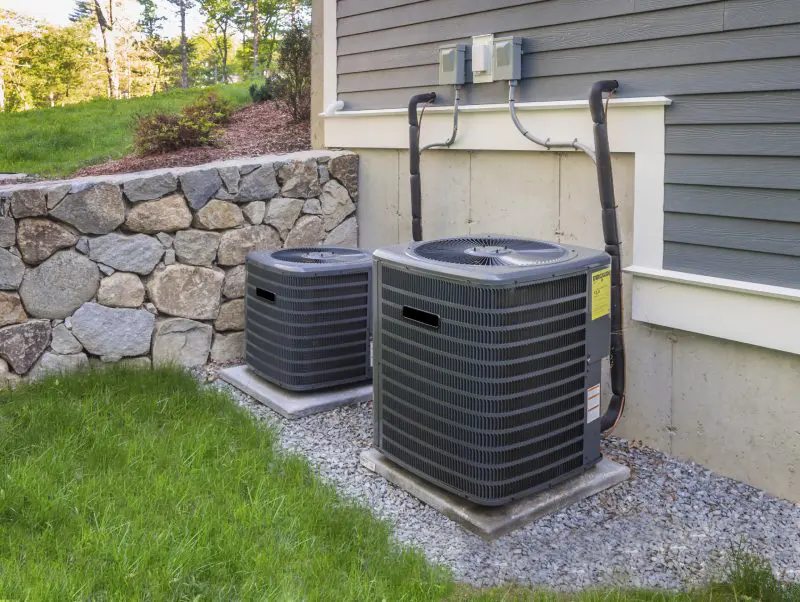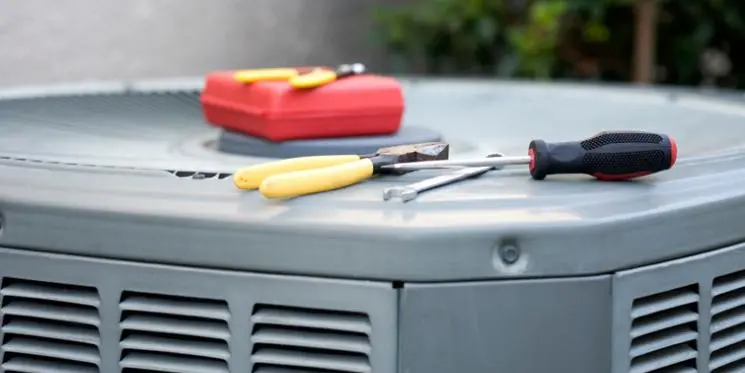Selecting an air conditioner proportional to the size and layout of your home is crucial for keeping each room sufficiently cooled in the summer months. In order to get the necessary info properly calculated, an energy consultant should visit your home to record the following:
- The entire quantity of living space — this is more than merely the square footage
- The position of each room and wall in relation to the sun
- The number of windows and their insulation quality
- The number of years since your home was built
- The quality of insulation, ventilation and ductwork
- The presence of neighboring homes, trees or tall neighboring structures that block sunlight from certain angles
Factors That Can Influence AC Sizing Needs
Sunlight
Out of all the external factors that affect the indoor temperature of a home, none are as powerful as the impact of the sun. If sunlight descends directly onto your property, your house will inevitably be vulnerable to summertime heat and humidity.
While conventional fans can offer moderate relief on days where temperatures peak in the 80° F to 83° F range, higher temperatures make air conditioning a basic household necessity. Sunlight can affect your household temperature in the following ways:
- Entering uninvited into your living room and bedrooms through windows, regardless of curtains or blinds
- Baking rooms like ovens, whether the rays are at 45° or 90° angles
Exposure
The exposure of your living quarters to direct sunlight can either be reduced or accentuated depending on the positioning of your house and the proximity of your house in relation to neighbors on any side. For now, let us consider your house to have a big yard around it, leaving out the need to assess shade from your neighbor’s house.
Facing North
The front rooms of your house will be least impacted if your house faces north, because the sun will always shine on either side of your home. If your house faces southward, the left side of your house could bear the strongest heat from sun-up to noon. By then, of course, your house will be so overheated that the peak temperatures of late afternoon will simply exacerbate the issue as the sun bears down on the right side of your home. The opposite effect takes place if your home faces northward. Still, these are your best two options, when exploring the direction your future home will face. The hottest houses are those that face east or west, because this gives the morning sun ample opportunity to blast its brightest rays straight through your front windows and the afternoon sun plenty of time to beam through your back windows, or vice versa. Because most people have their largest windows at the front or back of their home, you should consider if those windows, or smaller side windows will be bearing the brunt of the sun’s rays when buying a home.
Beating the Heat in Houses Facing East or West
If your front room faces eastward, the best arrangement would be to have a tree that blocks the rising sun from dawn until the afternoon. By the time the sun moves overhead, the brightest of rays will have passed and the sun will now face beyond your house from the west. Even as temperature levels peak outdoors, the impact on your house won’t be nearly as severe as it would be with full sunrise exposure.
Shade
The impact of sunlight on your house can be significantly reduced by the presence of objects that block the sun’s rays, either in full or in part. A nearby high rise, for example, could place your entire house comfortably in the shade. Even your next-door-neighbor’s house can significantly affect the shade your house receives, depending on how far apart your homes are. In residential neighborhoods, where neighbors are close – but not too close, your likeliest sun guard is a tall, thick tree, which could keep your windows shaded during the brightest hours when sunrays peak.
On shaded parts of your house, heat reduction can be significant. According to the EPA, shaded surfaces are anywhere from 20° F to 45° F cooler than unshaded surfaces during hours of peak humidity. When you consider how indoor humidity often starts with the heating up of walls, the barrier of a tree could be crucial to the comfort of your living quarters.
Structure
The temperature within your home can also be impacted by its structural insulation. If your house was built decades ago, there could be gaps in certain places that allow hot air to seep in and coolness to leak out in the summertime, and vice versa during winter months. You could also be lacking in insulation between walls and in the attic if your home has one.
Narrow, paper-thin gaps can sometimes be found along the edges of front doors, as well as along screen doors in back. Despite the narrowness of these gaps, significant leaks of air can transpire that will ultimately degrade your insulation and drive up cooling and heating costs.
Common Sources of Leaks
Leaks can come from a variety of sources. Problem spots in your home’s structure that allow for air passage are often found along the eaves of roofs, the vents of crawlspaces and other tiny openings. Basically, if rats or mice can slip in or out of your house, so too can the comfort of your indoor air.
WINDOWS
When it comes to the saturation of indoor temperatures, no architectural feature leaves a house more vulnerable than windows. As such, your insulation could largely hinge on the number of windows that grace your house. Just as significant to your indoor cooling and heating is the size of each window, the thickness of the panes and their position in relation to the sun.
GAPS
The thing that can make windows the most vulnerable of features is the possibility of gap formation around the edges. Just as it is with doors, but even more common in frequency, hair-thin gaps can gradually form along the frames and sills of windows. Throughout the course of a given year, such gaps can lead to increased cooling and heating costs as your HVAC system struggles to compensate for air leaks.
As far as air conditioning goes, leaky windows are one of the primary causes of inefficiency. The problem is most common in older homes, where time and the elements will have often formed cracks along the seams.
Region
The factors that can affect the indoor temperature of a house will be intensified in Florida. In the Sunshine State, temperatures average around 90° F throughout the months of June, July and August. Consequently, demand for air conditioning units in Florida peak around this time in places like Tampa, Saint Petersburg, Kissimmee, Mel born, Jacksonville, Bradenton, Sarasota, Fort Myers, Naples and Orlando. In the subsequent months, sunshine remains a heating issue. In non-peak months, our beautiful sunshine can also be a constant source of unwanted home heating.
Combatting this unwanted heat is easier than you think. Two simple steps can drastically reduce the suns impact on your home’s temperature. When you’re gone during the day, close your blinds. By blocking the majority of the sun’s rays, you reduce its effectiveness in heating your home. In addition, most Florida homes have a ceiling fan that can keep air circulating – just be sure you have it rotating in the proper direction to reduce heat!
Choosing the Right Air Conditioning Size
When it comes to the selection of an air conditioning system, the size of the system must satisfy the proportions of a house. If a system is either too large or too small for a given property, the results will inevitably be insufficient cooling and high energy costs.
Too Large
When an AC system is too large for a house, the humidity levels will be higher than normal, the system acts in cycles that are short but rarely runs long enough to dehumidify the home. Given the power involved, large air conditioning systems are able to cool air fast, but uses as much if not more power than a properly sized system.
Therefore, the short on-cycles of an oversized AC system will typically have only temporary effects, and so the cycle must be repeated time and again on humid days.
In short, houses equipped with oversized AC systems are bound to experience the following:
- Humidity in the home will be high reducing comfort
- Constant stop/start cycles drives up energy costs
Too Small
Different yet similar problems can occur when an AC system is too small for the size and layout of a house. If the size of the unit is to small the home will not maintain the temperature settings. During the heat of the day the temperature in the home will rise and the unit will not cycle.
To summarize, AC systems that are too small for a given house are bad for the following reasons:
- Rooms cool down too slowly
- Some rooms fail to cool
- The AC unit must run all day
- Coolness never reaches certain rooms
Overall, an undersized system will not consume as much energy as an oversized one, simply because more energy is consumed by the frequent stop/start cycles of the latter setup.
Just Right
In order for an air conditioning system to provide a home with sufficient coolness, it needs to be sized to accommodate the layout and footage of the house. Only this way can families feel comfortable while staying indoors during humid months, because only an adequately sized AC system can reach every room in reasonable time with the utmost efficiency.
Apart from size, it is important to consider choosing a variable speed unit. These units save energy and improve efficiency. Variable speed units are available in large and small units. Del-Air’s team of experts are equipped to determine the size of unit you’ll need and if variable will be of benefit to you. Our experts in load calculation provide their service to hundreds of builders in the state and can present you with accurate calculations for unit size.
Air Conditioner Sizing: The Meaning of TON and SEER
Air conditioners are sized in terms of tonnage, in which one ton — not to be confused with weight measurements of two-thousand pounds — is equal to 12,000 British Thermal Units (BTUs) per hour. The British thermal unit (BTU or Btu) is a traditional unit of work equal to about 1055 joules. It is the amount of work needed to raise the temperature of one pound of water by one degree Fahrenheit (Physical analogue: one four-inch wooden kitchen match consumed completely generates approximately 1 BTU).
At those ratings, an average-sized home might have a 2-ton AC system that lowers temperatures at 12,000 BTU/hour, while the system in a larger home might be rated 4-ton/24,000 BTU.
The United States Department of Energy recommends that a heat load calculation be completed whenever a new A/C system is sized for a home or business.
With air conditioners, equal tonnage does not mean equal efficiency. Two models that are both 3-ton, for example, could have different Seasonal Energy Efficiency Ratio (SEER) ratings. When you shop for an AC system, it’s important to check the SEER rating, because this will indicate whether the system will work within your budget. As a rule of thumb, each number up in SEER rating equals 5% greater efficiency. Therefore, an air conditioner rated at 16 SEER will be about 20% more energy efficient than an older model rated at 12 SEER.
ACs that bear the ENERGY STAR® rating are within the 14 to 23 SEER range.
Professional Air Conditioner Sizing: Load Calculation Methods
The way that contractors determine air conditioner size for house sizing measurements is more complex than the simple math and chart estimates that amateurs use. Contractors generally use one of two load-calculation methods: one involves the calculation of various factors throughout an entire house, while the other calculates various factors in each room and then adds them all for a collective sum.
Both methods are used to reach the calculation that contractors refer to as “Manual-J.”
Whole-House Loads
This method calculates the cooling needs of a given house by factoring all the conditions that can impact indoor temperatures, including the following:
- The thickness of walls and the ability of heat to pass through
- The number of windows and their overall quality
- The quality of insulation used in the walls, attic and crawlspace
- The presence of skylights over kitchens, living rooms or bedrooms
- The type and quantity of lighting used throughout the house
- The quality and layout of the ducting
- The number of inhabitants — one person emits roughly 250 BTUs in a given hour
Room-by-Room Loads
Similar to the whole-house method, but factoring everything on a room-by-room basis, this method also looks at everything from wall thickness and window count to lighting, ducting and insulation. Given the differences between small and large rooms, this method is likelier to account for the following variables:
- The difference in thickness between certain walls and the presence or lack of wall cavities
- The size and layout of living room windows versus kitchen and bedroom windows
- The different types of lighting in each room, such as kitchen chandeliers and bedroom lamps
Out of all the sizing methods in use by HVAC professionals, the room-by-room load method is best for calculating air conditioner size in proportion to the layout, measurements and external factors of a given house. However, both methods can be sufficiently accurate.
As such, the simpler whole-house method is expedient for houses in which ductwork won’t be replaced along with the installation of an AC system, whereas the room-by-room method is necessary when the job involves both AC installation and new ducting.
Additional Things to Consider About AC Installation
Ducting
A special note must be made regarding residential ducting, which has developed into something more efficient and reliable in recent decades. In older homes, ducting consisted of little more than simple tubes that connected to each room. Today, ducting is designed to account for the individual needs of each room. For example, a hot living room that faces the sun will need additional ducting and a second register, whereas rooms on the shaded side can generally do with simpler tubes.
It must be understood that each home is different, and that regardless of the general recommendations for houses of a given size or layout, your house could have entirely different cooling needs than a similarly sized home across the street. Therefore, choosing the right air conditioning size for your house is a job best done with the help of an HVAC contractor, who can perform a load calculation of your house and direct a work crew throughout the installation process.
Maintenance
Once your home is equipped with a new air conditioning system, you’ll want to do your part to keep it running efficiently for many years to come. To help ensure the longest possible lifespan for your AC system, clean your HVAC filters on a regular basis. Ideally, maintenance should be performed every spring and fall for maximum performance of your cooling and heating equipment.
EQUIP YOUR HOUSE WITH A PERFECTLY SIZED AC SYSTEM
The heat that engulfs Florida from spring through fall has made air conditioning a household necessity throughout the state. As such, there are as many people basking in the comforts of their living rooms as there are people heading to the sands in the summer months.
However, despite the popularity of air conditioning units in Florida, many people are missing the full comfort potential due to incorrectly sized systems, poorly maintained units and faulty ductwork. Consequently, energy costs are often a lot higher than necessary for a whole lot of Floridians.
Efficiency and comfort can both be improved with accurate air conditioner size for house sizing calculations, which are offered in Tampa, Orlando, Jacksonville, Sarasota, Naples, Fort Myers, Melbourne and Kissimmee, by Del-Air. As one of central Florida’s most trusted names in the HVAC business, we provide the area’s residents with AC units, installations, maintenance and calculations. With one of the Energy Star-certified AC models in our inventory, you could enjoy coolness during the hottest days of summer from the comfort of your living room.
Selecting an AC system for your home becomes a straightforward process when you contact the professionals here at Del-Air. As one of the leading providers of HVAC services in the Tampa area, we have installed AC systems in homes of all sizes throughout the Big Guava. To find out more about our installations and maintenance services, or to schedule an appointment with a Del-Air technician, visit our contact page right now.






